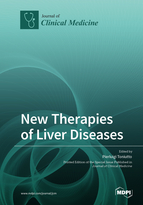New Therapies of Liver Diseases
A special issue of Journal of Clinical Medicine (ISSN 2077-0383). This special issue belongs to the section "Gastroenterology & Hepatopancreatobiliary Medicine".
Deadline for manuscript submissions: closed (31 July 2021) | Viewed by 53478
Special Issue Editor
Interests: hepatocellular carcinoma; hepatitis B; hepatitis C; liver cirrhosis; liver diseases; liver transplantation; cirrhosis; chronic hepatitis C; hepatology
Special Issue Information
Dear Colleagues,
For many years, liver diseases were thought to be incurable. Hepatologists were resigned to witnessing the progressive decay of liver function, up to the onset of liver failure, without being able to significantly modify the natural history of the disease with pharmacological therapies. Over the past few years, however, we have seen very rapid progress in scientific research in hepatology, which has led to two important results. The first was the availability of new drugs for the treatment of hepatitis C, which made it possible to heal all patients with the disease. The second is the growing understanding of the pathophysiological mechanisms responsible for the progression of liver damage and the development of clinical complications. This has led to the identification, for numerous liver diseases, of precise drug therapy targets, which for the first time have been shown to substantially modify patient survival.
Never before this very recent period has there been a real therapeutic revolution in the hepatology field that is expected to significantly improve the prognosis of liver diseases in the near future. In the present Special Issue, we aim to collect a number of review and original articles that highlight significant advances in the discovery and application of new treatment options for many liver diseases. Specific chapters will be dedicated to the advances of pharmacological treatment of cholestatic liver diseases and to the new treatment options to obtain a functional cure in hepatitis B virus infection. A specific section of the issue will be dedicated to the more recent advances in pharmacological treatments to prevent and/or reverse the main complications of end stage liver disease as the development of ascites, gastrointestinal bleeding, hepatic encephalopathy, and acute on chronic liver failure. New treatment modalities for hepatocellular carcinoma and cholangiocarcinoma will be extensively discussed, taking into account the recent availability of immunotherapy in addition to the established treatment options. A particular attention will be reserved for liver transplantation, analyzing the new potential indications as well as the use of DCD donors, and the potential support of stem cell transplantation.
In summary, this Special Issue will help readers to get an up-to-date and authoritative view of how new therapies will continue to improve the clinical management of patients with liver diseases in the forthcoming future.
Dr. Pierluigi Toniutto
Guest Editor
Manuscript Submission Information
Manuscripts should be submitted online at www.mdpi.com by registering and logging in to this website. Once you are registered, click here to go to the submission form. Manuscripts can be submitted until the deadline. All submissions that pass pre-check are peer-reviewed. Accepted papers will be published continuously in the journal (as soon as accepted) and will be listed together on the special issue website. Research articles, review articles as well as short communications are invited. For planned papers, a title and short abstract (about 100 words) can be sent to the Editorial Office for announcement on this website.
Submitted manuscripts should not have been published previously, nor be under consideration for publication elsewhere (except conference proceedings papers). All manuscripts are thoroughly refereed through a single-blind peer-review process. A guide for authors and other relevant information for submission of manuscripts is available on the Instructions for Authors page. Journal of Clinical Medicine is an international peer-reviewed open access semimonthly journal published by MDPI.
Please visit the Instructions for Authors page before submitting a manuscript. The Article Processing Charge (APC) for publication in this open access journal is 2600 CHF (Swiss Francs). Submitted papers should be well formatted and use good English. Authors may use MDPI's English editing service prior to publication or during author revisions.
Keywords
- Cholestatic Liver diseases
- a. Primary Biliary Cirrhosis (PBC)
- b. Primary Sclerosing Cholangitis (PSC)
- Viral hepatitis
- a. HBV and HDV new treatments on horizon
- Cirrhosis
- a. Prevention of cirrhosis complications
- b. Ascites
- c. Gastrointestinal bleeding
- d. Hepatic encephalopathy
- e. Acute on chronic liver failure
- Hepatocellular carcinoma
- a. New medical treatments and new potential combination treatment strategies
- Cholangiocarcinoma
- a. New treatment options
- Liver Transplantation
- a. HCC exceeding Milan criteria
- b. New indications for liver transplantation
- c. Stem cell transplantation







